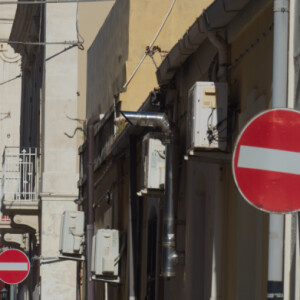Quarry
I know I said it yesterday, but the scale of ancient Syracuse has shaken me.
It's not only its age (and after I went to the archaeological museum today I discovered it goes much further back - there is one piece of evidence of settlement from Neolithic times on the island of Ortigia in what is now the Temple of Athena/Cathedral area, more from the Early Bronze age (22nd-15th centuries BC) and yet more - a large well and some huts with floors made of baked clay - from the middle bronze age (16th-14th centuries BC). This goes beyond my ability to count years.)
It's also the size of the settlement. This afternoon I visited Neapolis, the most extensive ancient site in Syracuse. It would have been used in ancient times for entertainment and public events and is almost two miles from the Temple of Athena/Cathedral, where the ancient city was founded. That feels like quite a hike to me.
The Greek theatre, from the 5th century BC, is huge but is still in use, so its worn stone seats, disappointingly, were covered with something that looked a bit more comfortable in white plastic. The largest known altar in the ancient world, of Hieron II, is from the third century BC. It's vast! To use it fully a phenomenal number of gods must have needed appeasing with animal sacrifices. Doesn't really bear thinking about. The Roman amphitheatre, for yet more slaughter, is about 200 years younger than that.
As part of the same site is a set of caves/quarry with fabulous acoustics. I'm ashamed to say that I didn't have the courage to start singing in there but on my way out I heard a police siren in what must definitely have been 4D. Moments later, the sound of a voice singing followed me so I raced back in and sang a third above it. Then there were two notes. I answered. Three, I answered and we set up a call and response. The other singer and I walked towards each other and it turned out he was from Plymouth. And has come here by train and will be going back by train. A kindred spirit, though I don't know his name.
Throughout this site, as in elsewhere in Syracuse, there are sculptures by Mito Raj (the Polish sculptor, Igor Mitoraj). He died ten years ago but they are so well chosen that they look site specific and together, if you find them all, they tell a mythic story. I am enormously impressed by Syracuse's approach to sculpture.
I wanted to walk up to the end of the site to see Archimedes' much-promoted alleged tomb. I do realise that in the unlikely event of him actually being buried there, not a cell, not a molecule, not even an atom of what was once Genius will still be in the same place. Even so, I wanted to pay homage. But no, the path was closed. Ah well, to have been within a mile of the original molecules was something. But when I got out of the site I realised I could walk round the exterior fence and get to the same place. The sign when I got there, inside the site that promotes the tomb, amused me no end: 'Archimedes tomb: Roman-aged tomb, it is incorrectly considered the place where the famous scientist from Syracuse was buried.'
Tonight I treated myself to a bottle of wine, to last two nights. I knew it had to have a screw top, since having come here by plane means I don't have my Swiss army knife, but in the shop I forgot. I can vouch for the fact that it is possible to gain access to wine through a cork using a bandage-pin and a door key. (I thought I'd grown up a bit beyond that, but seems not...)
Extra
- just no


Comments
Sign in or get an account to comment.


